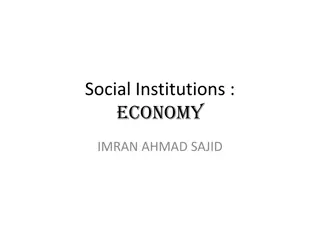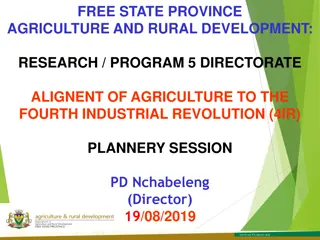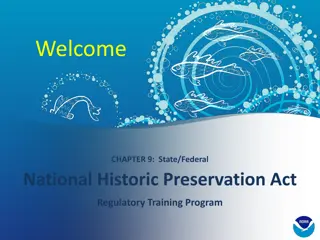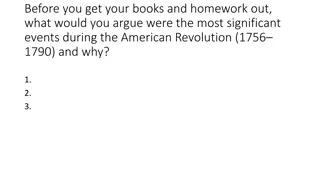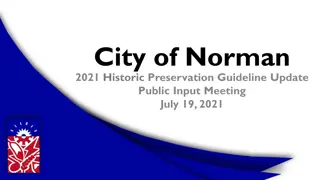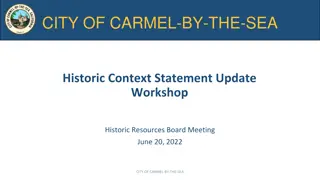The Berlin Revolutions of 1848: A Historic Perspective
The Berlin Revolutions of 1848 were part of a series of widespread uprisings across Europe, driven by a mix of liberal and working-class goals. The revolutions aimed to challenge the existing autocratic political structure in the German Confederation and the Austrian Empire. Despite initial hopes for democratic reforms, the movements faced repression, notably with the imposition of a monarchist constitution by King Frederick William IV of Prussia. The episode also led to the formation of the Berlin Emigration Society, reflecting the disillusionment of some individuals with the political situation.
Download Presentation

Please find below an Image/Link to download the presentation.
The content on the website is provided AS IS for your information and personal use only. It may not be sold, licensed, or shared on other websites without obtaining consent from the author.If you encounter any issues during the download, it is possible that the publisher has removed the file from their server.
You are allowed to download the files provided on this website for personal or commercial use, subject to the condition that they are used lawfully. All files are the property of their respective owners.
The content on the website is provided AS IS for your information and personal use only. It may not be sold, licensed, or shared on other websites without obtaining consent from the author.
E N D
Presentation Transcript
175THANNIVERSARY OF THE BERLIN REVOLUTIONS 1848 PHILIP MANN AND SHARON MANSELL
WHAT BERLIN REVOLUTION? 2 Revolutions broke out in many European countries in 1848. Inspired by street demonstrations of workers and artisans in Paris, France, in February 1848, which resulted in the abdication of King Louis-Philippe and his exile in Britain. German revolutions were loosely coordinated protests and rebellions in the states of the German Confederation and the Austrian Empire.
WHAT BERLIN REVOLUTION? (CONT) 3 The revolutions demonstrated popular discontent with the traditional, largely autocratic political structure of the thirty-nine independent states of the Confederation that inherited the German territory of the former Holy Roman Empire after its dismantlement as a result of the Napoleonic Wars.
CONFLICT OF AIMS 4 The middle-class elements were committed to liberal principles. The working class elements sought radical improvements to their working and living conditions.
SQUASHING OF GERMAN REVOLUTIONS 5 Constituent National Assembly elected from German states in late April and early May 1848 and gathered in Frankfurt am Main on 18 May 1848. Became known as the "professors' parliament", as many of its members were academics in addition to their other responsibilities. The Assembly was unable to pass resolutions and dissolved into endless debate.
SQUASHING OF GERMAN REVOLUTIONS (CONT) 6 King Frederick William IV of Prussia unilaterally imposed a monarchist constitution in Prussia and undercut the democratic forces. Prussian troops aided local militia in other German States to crush subsequent uprisings. Leaders and participants, if caught, were executed or sentenced to long prison terms.
THE BERLIN EMIGRATION SOCIETY (OR THE SOUTH AUSTRALIAN COLONISATION SOCIETY) 7 In Berlin, in 1848, Richard Schomburgk, a gardener with a reputation as a botanist, and his physician brother, Otto, saw that there was little hope of their dream of democracy being achieved. They formed a migration group, with other families, calling it the Berlin Emigration Society (later changed to the South Australian Colonisation Society, when South Australia became the destination), and made plans to leave. In March, 1849, the Society chartered the Princess Louise (356 tons, Captain Bohr), which left Hamburg on 26 March 1849 and arrived in Port Adelaide on 7 August 1849.
PASSENGERS ON THE PRINCESS LOUISE 8 The Society was largely comprised of professional men, businessmen and skilled artisans, and has been called "the single most important group of German intellectuals to come to Adelaide". 161 passengers travelled; the next few slides are a selection, showing considerable diversity.
Painting of the barque Princess Louise' is from Pauline Payne, 'The Diplomatic Gardener , Page 73. 9
PASSENGERS ON THE PRINCESS LOUISE (CONT.) 10 Carl Friederich Wilhelm Adelbert Hermann von RIEBEN, publican, born 1809, Baden-W rttemberg, died 1879, Morgan SA. Johann Hartwig HARDERS, cabinetmaker, born 1798, Itzehoe, Steinburg, Schleswig-Holstein, died 1886, Dimboola VIC. Carl Wilhelm Ludwig MUECKE, educationist, farmer, journalist, Lutheran pastor, newspaper editor, newspaper owner, orator born 1815, Baden, Baden-Wurttemburg, died 1898, Hahndorf SA. Moritz Richard SCHOMBURGK, botanic gardens director, botanist, winemaker born Freyburg, Saxony 1811, died Adelaide SA 1891. Otto Alfred Carl SCHOMBURGK, Lutheran Pastor, born Freyburg, Saxony 1809, died Buchsfelde SA 1857.
PASSENGERS ON THE PRINCESS LOUISE (CONT.) 11 Johann Carl Friedrich FAEHRMANN, carpenter, carrier and farmer born Tangerm nde, Saxony 1828, died Hahndorf SA 1896. Friedrich Otto PIEPER, farmer, born 1825, Tangerm nde, Stendal, Saxony-Anhalt, died 1873, Bendigo, VIC. Joachim Friedrich Wilhelm SALAU, vigneron farmer, born 1825, Tangerm nde, Stendal, Saxony- Anhalt, died 1890, Bendigo, VIC. Hermann HOLZERLAND, architect, farmer, gardener, born 1813, Tangerm nde, Saxony, died 1899, Woodside SA. Friedrich Wilhelm VON LINDRUM, champion billiards player, winemaker and hotel landlord, born Mecklenburg-Vorpommern, 1828, died Port Victor SA (now Victor Harbor), 1880.
PASSENGERS ON THE PRINCESS LOUISE (CONT.) 12 Theodor Gustav Hermann BURING, store-keeper and vigneron born 1846, Berlin, Brandenburg, died 1919, Kent Town SA. Carl Ferdinand August LINGER, musician and composer, born 1810, Berlin, Brandenburg, died 1862, Adelaide SA. August Albert KLEY, farmer, publican and master carpenter, born Berlin 1813, died 1872 Stockwell SA. Carl Friedrich Alexander SCHRAMM, painter and artist, born Berlin 1813, died Adelaide SA 1864. Johann Heinrich HADDERS/HARDERS, farmer and judge at field trials, born 1826, Brandenburg, died 1915, Dimboola VIC.
PASSENGERS ON THE PRINCESS LOUISE (CONT.) 13 Andreas Adolph KLEY, cabinetmaker, born 1818, Obernhof, Rhein-Lahn-Kreis, Rhineland-Palatinate, died 1890, Lyndoch Valley SA. Maria Anna Eugene Constance Josephine (Marianne) KREUSLER, farmer, entomologist and naturalist, born Brilon, Hochsauerlandkreis, North Rhine-Westphalia 1811, died Nuriootpa SA 1892. Franz Anton JORASLAFSKY, farmer born Warsaw 1818, died Aldinga SA 1899. Heinrich Carl August NIENABER, cabinetmaker, born Hamburg 1820, died Hamburg, Germany, 1882 accompanied by his wife and son, Otto Heinrich NIENABER, piano and harmonium tuner and repairer born Hamburg, Germany, 1846, died St Peters, SA, 1927.
14 SOURCES SOURCES http://www.theshipslist.com/ships/australia/princesslouise1849.shtml. bound-for-south-australia.collections.slsa.sa.gov.au/1849PrincessLouise.htm. https://en.wikipedia.org/wiki/German_revolutions_of_1848%E2%80%931849#B acklash_in_Prussia. https://localwiki.org/adelaide-hills/Ship_Princess_Louise_%287Aug1849%29. Pride of the Princess , The Advertiser , 2 December 1989. Trove, Ancestry, etc.
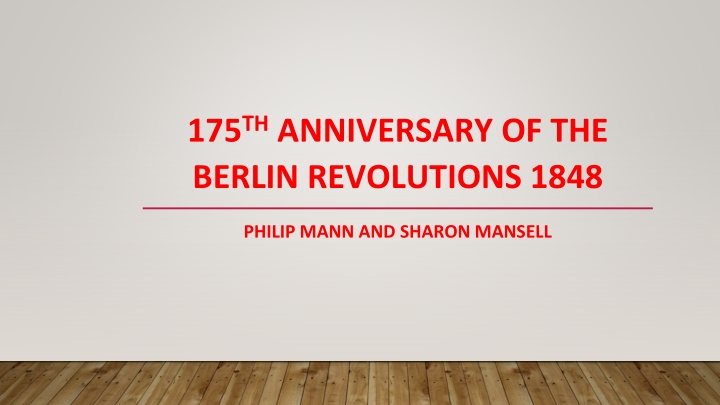



![❤[PDF]⚡ Apollo Mission Control: The Making of a National Historic Landmark (Spr](/thumb/21551/pdf-apollo-mission-control-the-making-of-a-national-historic-landmark-spr.jpg)




